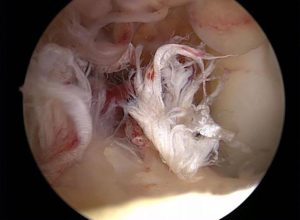Anterior Cruciate Ligament Injury Prevention Frequently Asked Questions
Below are answers to some of the most frequently asked questions about anterior cruciate ligament (ACL) injury prevention.
- Can All ACL Injuries Be Prevented?
- Which Sports Are High Risk?
- How Do ACL Tears Happen?
- What Are ACL Tear Symptoms?
- What Can I Do to Prevent an ACL Injury?
- What if I Stop Doing Prevention Exercises?
- What Can We Do Overall to Prevent ACL Tears?
- Can I Train My Child While She’s Young So the Benefits Last a Lifetime?
Can All ACL Injuries Be Prevented?
We can’t prevent all ACL injuries, but we can reduce the risk. The majority of ACL injuries happen without contact. These occur most commonly when planting hard to change directions or landing from a jump. ACL injury prevention programs are mainly designed to prevent these noncontact ACL injuries. A prevention program can have a significant impact.
Which Sports Are High Risk for ACL Injuries?
This list is a guide rather than a rule. Risk is also related to the intensity and frequency of play and practices. Sports with similar movements may have similar risk.
HIGH RISK: Basketball, soccer, lacrosse, rugby, American football, handball, field hockey, skiing, volleyball and squash.
RELATIVELY LOW RISK: Ice hockey, tennis, baseball and cross-country running.
VERY LOW RISK: Golf, cycling, jogging and weight training.
How Do ACL Tears Happen?

Unfortunately, your body can move in ways your knee ligaments can’t support. When that happens, the fibrous ligament tissues stretch or tear. An ACL tear usually happens when jumping, turning or moving suddenly while running. Most of the time, the injury happens without contact. An ACL tear (also called a rupture) is the most common knee injury.
What Are ACL Tear Symptoms?
When your ACL tears:
- Seventy percent of those suffering an ACL tear feel or hear a pop.
- You’ll feel pain that increases when you bend your knee or try to walk. It may hurt to put any weight on that leg.
- Usually your knee will swell quickly.
- Your leg might feel unstable. This is because your shin can move forward beyond its natural range (called loss of anterior stability). Also swelling and pain in your quadriceps (front of thigh) keeping the muscle from working properly.
- Your range of motion might be severely limited. It will be painful to straighten your leg.
What Can I Do to Prevent an ACL Injury?
The basic principles of prevention include balance, strength and position/knee alignment. These can be achieved with simple exercises. (For example, start standing on one leg. Hold it for as long as you can. If you are good at it, try bending the knee that is in the air. Try it with your eyes closed. Even smaller children can learn to jump off small heights, bend their knees and keep their knees over their toes as they land.) Good form when landing and decelerating is a key part of ACL injury prevention.
What if I Stop Doing Prevention Exercises?
You lose the benefits. Research shows that injury rates return to baseline if the athletes stop doing the prevention program. Exercises must be done continuously. The most logical and efficient way to achieve this is to incorporate the program into your normal warm-up for practices.
What Can We Do Overall to Prevent ACL Tears?
Prevention programs to reduce the risk of ACL injury should be implemented by all schools as part of their physical education curriculum. Kids as young as elementary school can do strengthening and simple balance exercises. They can progress to more challenging movements in middle and high school. Coaches for high-risk sports should implement ACL injury prevention programs as part of their warm-ups.
Can I Train My Child While They’re Young So the Benefits Last a Lifetime?
This question has not been scientifically studied. However, children do learn motor patterns at a young age. It’s possible that teaching principles of ACL prevention in gym classes at the elementary and middle school level can lead to lasting neuromuscular pathways.
Was This Content Helpful?
Share via:

